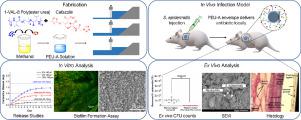Acta Biomaterialia ( IF 9.7 ) Pub Date : 2020-05-22 , DOI: 10.1016/j.actbio.2020.04.025 Shantanu P Nikam 1 , Karissa Nettleton 1 , Jeffrey I Everitt 2 , Hazel A Barton 3 , Matthew L Becker 4

|
Cardiac implantable electronic device (CIED) infections acquired during or after surgical procedures are a major complication that are challenging to treat therapeutically, resulting in chronic and sometimes fatal infections. Localized delivery of antibiotics at the surgical site could be used to supplement traditional systemic administration as a preventative measure. Herein, we investigate a cefazolin-eluting l-valine poly(ester urea) (PEU) films as a model system for localized antibiotic delivery for CIEDs. Poly(1-VAL-8) PEU was used to fabricate a series of antibiotic-loaded films with varied loading concentrations (2%, 5%, 10% wt/wt) and thicknesses (40 µm, 80 µm, 140 µm). In vitro release measurements show thickness and loading concentration influence the amount and rate of cefazolin release. Group 10%-140 µm (load-thickness) showed 22.5% release of active pharmaceutical ingredient (API) in the first 24 h and 81.2% of cumulative percent release through day 14 and was found most effective in bacterial clearance in vitro. This group was also effective in clearing a bacterial infection in a model in vivo rat study while eliciting a limited inflammatory response. Our results suggest the feasibility of cefazolin-loaded PEU films as an effective sustained release matrix for localized delivery of antibiotics.
Significance Statement
Implant-associated infections acquired during surgical procedures are a major complication that have proven a challenge to treat clinically, resulting in chronic and sometimes fatal infections. In this manuscript, we investigate an antibiotic-eluting L-valine poly(ester urea) (PEU) films as a model system for localized delivery of cefazolin. Significantly, we demonstrate a wide variation in temporal delivery and dosing within this family of PEUs and show that the delivery can be extended by varying the film thickness. The in vivo results show efficacy in an infected wound model and suggest antibiotic loaded PEU films function as an effective sustained release matrix for localized delivery of antibiotics across a number of clinical indications.
中文翻译:

抗生素洗脱聚(酯脲)薄膜,用于控制模型心脏植入式电子设备感染。
在外科手术过程中或之后获得的心脏植入式电子设备(CIED)感染是主要并发症,在治疗上具有挑战性,导致慢性感染,有时甚至是致命感染。作为预防措施,可以在手术部位局部使用抗生素来补充传统的全身给药。在本文中,我们研究了头孢唑啉洗脱的1-缬氨酸聚(酯脲)(PEU)膜作为CIEDs局部抗生素递送的模型系统。Poly(1-VAL-8)PEU用于制造一系列具有不同加载浓度(2%,5%,10%wt / wt)和厚度(40 µm,80 µm,140 µm)的抗生素加载膜。体外释放测量表明厚度和负载浓度影响头孢唑啉释放的量和速率。10%-140 µm组(负荷厚度)显示在头24小时内活性药物成分(API)释放22.5%,到第14天累积释放百分比的81.2%,被发现在体外清除细菌方面最有效。在体内大鼠模型研究中,该组还可以有效清除细菌感染,同时引起有限的炎症反应。我们的结果表明,头孢唑啉负载的PEU膜作为局部递送抗生素的有效缓释基质的可行性。
重要性声明
在外科手术过程中获得的与植入物相关的感染是一种主要并发症,已被证明对临床治疗具有挑战性,导致慢性感染,有时甚至是致命感染。在此手稿中,我们研究了一种抗生素洗脱的L-缬氨酸聚(酯脲)(PEU)膜作为局部递送头孢唑林的模型系统。重要的是,我们证明了该PEU系列在时间传递和剂量方面存在很大差异,并表明可以通过改变膜厚度来延长传递。该体内结果在感染的伤口模型显示出功效,并建议抗生素加载PEU膜用作用于跨越多个临床适应症的抗生素局部递送的有效持续释放基质。



























 京公网安备 11010802027423号
京公网安备 11010802027423号